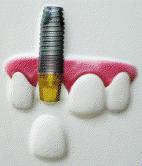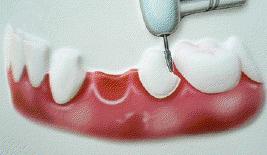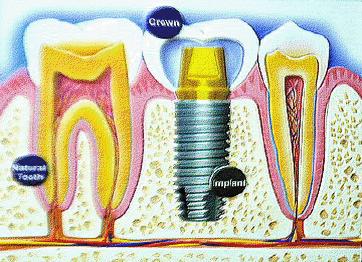What are dental implants? What are they made of?
Dental implants can be said to be the replacement of the tooth roots. Currently they are made of titanium. Dental implants are skillfully machined into the shape of perfectly formed tooth roots. They come in many different lengths and diameters. They sit in the bone like our normal tooth roots. They are used to help carry one or more teeth on top.
 Why do I need dental implants?
Why do I need dental implants?
When you realize that your tooth/teeth have gone so bad that repairing them are not worthwhile, you will have to extract and replace them. Currently, there are only three ways to replace missing teeth.
Plastic dentures are cheap, but they are not very hygienic, they affect the gum tissues, they trap food and may cause further tooth decay, and they affect your speech.
Bridges require you to trim down the teeth on either side of the missing tooth. A row of teeth are cast in the laboratory and fitted over the trimmed teeth. While this is a more hygienic alternative than the denture, they require good tooth structure to be trimmed and sacrificed.

When a row of teeth is linked in this way, any problem happening to just one member tooth would require
the entire bridge to be removed. Logically therefore, if the adjacent teeth used for the bridge are perfect and without defect, they are most likely to produce a lasting result. Paradoxically, when they are perfect, a lot of people are loathe allowing the dentist to trim them down. Conversely, when they have been heavily filled, most people would be very happy to have them covered over with shiny new porcelain, not realizing that using heavily weakened teeth to carry more weight in a bridge may cause them to fail earlier.
Dental implants are currently the best way to replace missing teeth. They have been used for many years now and have a proven track record of high success rates. They resemble our natural teeth architecture best because they allow the replacements to remain individual for easy cleaning like our own teeth. They are flexible in allowing single teeth, bridges or even dentures to be fitted on top.
 However, as with all materials, it is important to understand their strengths and limitations to achieve the best results. They do not suffer from decay or root canal problems, but they need to sit in healthy gums and bone just like natural teeth. Implants will fail very rapidly if the oral hygiene is poor and there is a lot of food trap around the teeth causing the gums to be inflamed and infected.. Therefore, long after they have been placed, implants must undergo regular cleaning maintenance just like natural teeth.
However, as with all materials, it is important to understand their strengths and limitations to achieve the best results. They do not suffer from decay or root canal problems, but they need to sit in healthy gums and bone just like natural teeth. Implants will fail very rapidly if the oral hygiene is poor and there is a lot of food trap around the teeth causing the gums to be inflamed and infected.. Therefore, long after they have been placed, implants must undergo regular cleaning maintenance just like natural teeth.
Are dental implants suitable for everybody? Are there any contra-indications for implants?
Generally, almost anybody can fit implants. Health wise, there are very few medical conditions that will prevent a person from doing dental implants. The elderly are also able to place implants if they are healthy. In fact, they are the age-group that will benefit most from implants as they tend to have very few teeth or too little bone height left to support dentures. Persons who have been on radiation in the head and neck area, or are taking intravenous bisphosphonates, or have been certified medically unfit for surgery should inform the dental surgeon beforehand.
Common conditions like high blood pressure, diabetes and even cardiac diseases do not prevent a person from having dental implants done. Conditions like osteoporosis may affect the success rate of dental implants but does not necessarily contra-indicate it.
What conditions affect the success rates of dental implants?
All conditions that affect the bone quality or quantity will affect the success rate of implants. Only a few medical conditions have an effect, like osteoporosis mentioned above. Dentally, long standing infections in the bone, which may be of tooth or gum origin, destroy both the volume and quality of bone. Therefore, it is important to quickly extract an infected tooth when it is diagnosed as being irreparable.
Importantly, you must do this before extensive destruction of the surrounding bone occurs. In addition, the presence of important structures, like nerves, sinuses, ridges or depressions, may limit the amount of bone available for implant placement. While the above has an effect on implant placement and success, they are not contra-indications. There are techniques to overcome these issues. A common remedy is by bone-grafting.
How will the final result turn out?
Functionally, after proper adjustment, it feels just like a natural tooth. However, implants are a mechanical assembly and require periodic maintenance on a long-term basis. Just like natural teeth. They should not be treated as fit and forget objects. Cosmetically, the fitted porcelain tooth looks very much like a natural tooth. However, many factors affect the aesthetics of the final result.
What factors affect the aesthetics of the final fitted tooth?
For the final restoration to look natural, it must appear as if it is a natural tooth emerging from the gums. Therefore, a pleasing appearance is the combined effect of the shape and colour of the porcelain tooth, the colour and thickness of the gums and the bony contours. This is a very challenging and demanding part of implant dentistry. You will quickly realize that the most demanding situations would be at the front of the mouth or where a single tooth is missing and the replacement needs to merge or blend in with the existing teeth.
In order to achieve this, additional surgery is often required. Bone grafting may be necessary to repair hollowed out depressions in the bone. Soft tissue grafting may also be necessary where gum tissue is taken from another part of the mouth and used to bulk up deficient areas at the restoration site. Additional time and cost is involved, but the result is rewarding for those who are willing to put in the effort.
Since they are not real teeth, do implants need any maintenance?
Yes, implants are not real teeth but they function and feel like real teeth. The appearance of the fittings you may see in your mouth may make it hard for you to think of them as teeth, but you must still see a dentist once every six months to maintain them. They are not ‘fit and forget’ structures. Like all mechanisms, they need to be maintained for them to function well continuously. The way we bite and the way teeth fit together do change with time. Therefore, continuous monitoring and adjustment will help to ensure that your implant restorations will remain with you for a very long time.